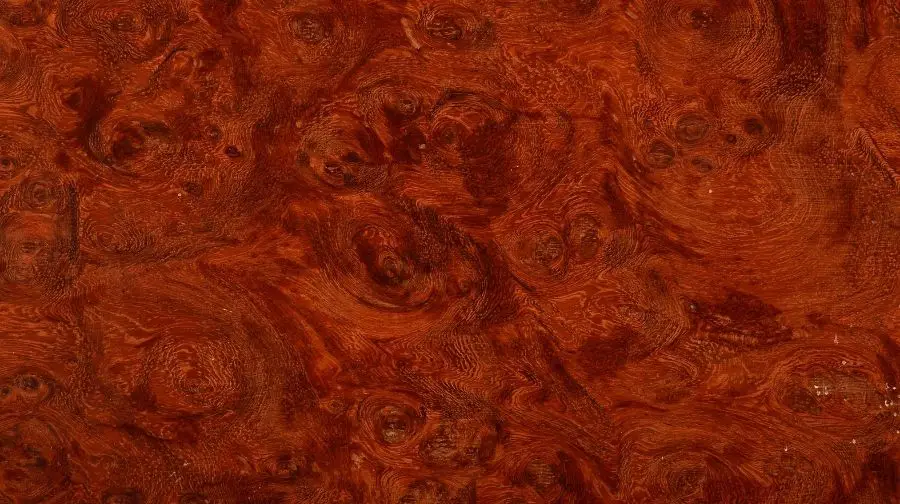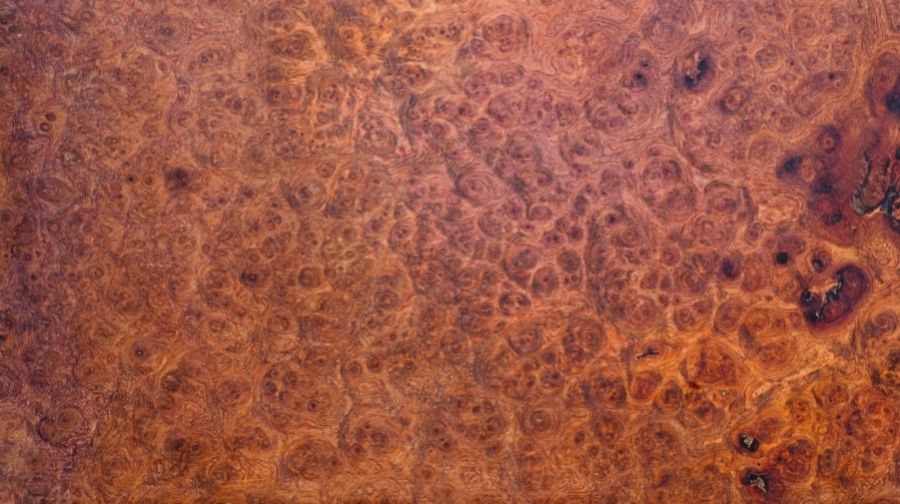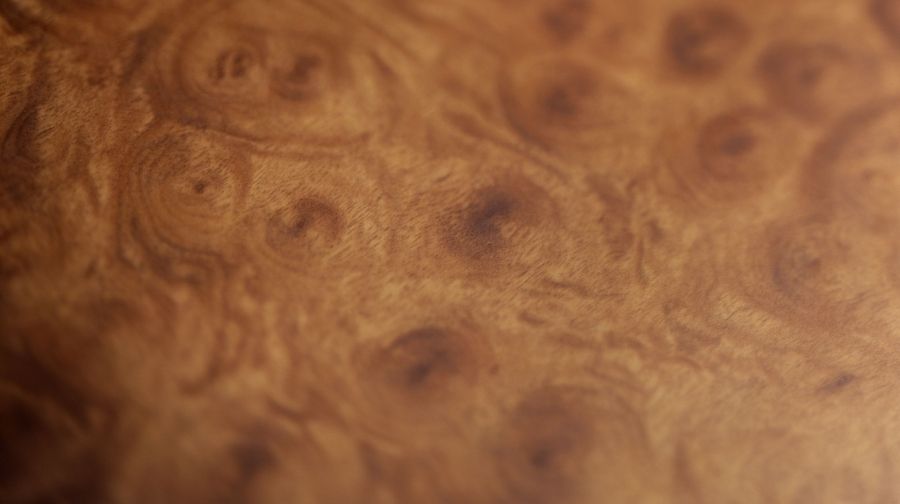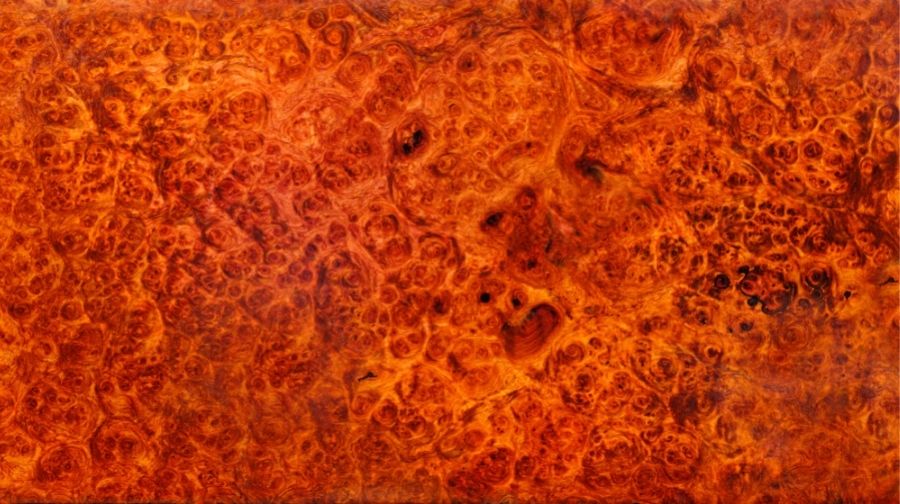
There’s a lot of burl veneer out there, but this article will help you find the best burl veneer for your projects. We’ll discuss what burl is, the different types of burls, and how to source it. Then we’ll talk about how to work with burl once you have it on hand. It might seem like a daunting task at first, but don’t worry! This guide has all the information you need to make your next project spectacular!
What Is Burl Veneer?
Burl veneer is a type of wood veneer that is made from the burl of a tree. A burl is an abnormal growth on a tree that is caused by some kind of stress, such as infection, insect damage, or lightning strike. Burls are often found near the base of the tree and can be quite large.
Burl veneer is prized for its beauty and uniqueness. The swirls and knots in the wood can be quite stunning, and no two pieces of burl veneer are ever exactly alike. This makes it a popular choice for high-end furniture and other decorative items.
Types of Burl Veneer
There are three main types of burl veneer: crotch, circular, and flame. Each has unique characteristics that affect how it’s best used.
Crotch Burl Veneer is named for the way the growths on trees form a Y shape, with one limb pointing up and another extending down toward the ground. Crotch veneer is usually the most expensive type. This is because it’s created when two trees grow intertwined, which makes for an especially beautiful piece of wood with exquisitely patterned swirls and lines.
Burl Veneers are typically sold in either quarter or half sheets. A full sheet can also be sourced, but this choice is usually reserved for the largest projects.
Crotch veneer is best suited to large and complex surfaces like doors, cabinets, and tabletops. It’s not suitable for smaller items like boxes or bowls because it would be difficult to cut small pieces from a full sheet of crotch veneer without wasting too much wood.
Circular Burl Veneer is a type of burl that grows in a circular pattern. It’s usually less expensive than other types of burl veneer and is, therefore, a good choice for budget-minded projects.
Circular burl veneer is best suited for smaller items like boxes, bowls, and pens. It can also be used for larger projects, but the patterns won’t be as intricate as those found in other types of burl veneer.
Flame Burl Veneer is a type of burl that has a wavy or flame-like pattern. It’s usually less expensive than other types of burl veneer and is, therefore, a good choice for budget-minded projects.
Flame burl veneer is best suited to smaller items like boxes, bowls, and pens. It can also be used for larger projects like cabinets or tabletops, but the patterns won’t be as intricate as those found in other types of burl veneer.
Subscribe to ContractorBhai Design Service on Youtube
How To Source Burls
Burls can be sourced in a few different ways. One option is to find a local lumberyard that sells burl veneer. Another option is to order online from a supplier like Woodworkers Source.
When sourcing burls, it’s important to know what you’re looking for. Not all burls are created equal, and not all suppliers carry the same types of burls. It’s also important to know the size of the burls you’re looking for. Most suppliers sell burls in either quarter or half sheets, so make sure to ask before you order.
How To Work with Burl Veneer
Burl veneer can be challenging to work with because it’s so delicate and prone to tearing. There are a few different ways you can ensure your finished project comes out as beautifully as possible:
– Make sure your tools are extremely sharp when working with burl veneer. Dull blades will tear the wood instead of cutting it, which creates jagged edges that leave an unsightly finish.
– Use a light touch when sanding burl veneer. Sanding too hard can easily damage the wood and create unsightly scratches.
– Apply a finish to your project as soon as possible after construction. This will help protect the delicate wood from moisture and further damage.
Burl veneer is difficult to work with, but the results are well worth it. It’s one of the most stunning types of wood veneer available and can be used for projects large or small. With just a little bit of care and attention, you’ll have a beautiful project that will last for years to come!
Burl Wood Veneering
Subscribe to Sweenor Builders on Youtube
How Do You Use a Burl Veneer?
You can use a burl veneer in a few different ways:
– As an overlay on furniture or cabinets
– Inlaid into the surface of furniture or cabinets
– Used as a tabletop
Is Burl Wood Expensive?
Burl wood is more expensive than other types of wood because it’s rare and difficult to find.
Can You Stain Burl Veneer?
Yes, you can stain burl veneer. However, it’s important to note that some types of burls are more difficult than others when it comes to staining. For example, bird’s eye maple is very hard and will be difficult to color with a light or dark shade because the individual markings are so small.
How Do You Protect a Veneer Tabletop?
One way to protect a veneer tabletop is to apply a finish as soon as possible after construction. This will help seal the wood and prevent moisture from damaging the surface. Another option is to use a table pad or cloth to protect the top from scratches and spills.

Maple Burl Veneer
The most common type of burl veneer is maple burl, which has a distinct grain pattern that looks beautiful when cut into thin strips. This type of burl can be found in several different shades and ranges from pale white to dark brown or reddish-brown hues.
Walnut Burl Veneer
The most common types of burl wood are walnut and maple, but there are several other types of burls available. One such example is the black walnut veneer, which features a dark brown grain pattern with occasional stripes or knots that create beautiful patterns when cut into thin strips.
Poplar Burl Veneer
Another type of common burl wood is poplar, which has a light brown grain pattern. This type of burl often features darker rings around knots or dark stripes along the length of the wood.
Dark Burl Veneer
One example of a less common but equally beautiful type of burl veneer is dark burl, which can be found in several different shades of dark brown. This type of burl is often used in high-end furniture and features a very distinct grain pattern.
Burl Veneer Coffee Table
One popular project that can be made with burl veneer is a coffee table. There are several different types of burls that can be used to create a beautiful and unique table, such as maple burl, walnut burl, and elm burl.
Elm Burl Veneer
Another type of burl that can be used to make a beautiful coffee table is elm burl. This type of burl has a very distinct grain pattern with swirls and curves that create an elegant look.
Mappa Burl Veneer
The most expensive and rare type of burl veneer is Mappa burl. This type of wood is found in tropical areas and has a very unique grain pattern with swirls and curves that create an elegant look.
Mappa Burl Wood Veneer Sheet
Subscribe to Volpe Woodworks on Youtube
Can I use a Burl Veneer for my next project?
The answer is definitely yes! With just a little bit of care and attention, you can use burl veneer to create beautiful projects that will last for years to come. For more information on how to use burl veneers in your projects, be sure to check out some of the other articles on our website.
What Is the Best Way to Cut a Burl Veneer?
There isn’t a single right way to cut a burl veneer, but you can follow some general guidelines. For example, it’s important to make sure the blade is sharp and that the table saw is in good working order before cutting any type of wood. You should also use a backer board to help keep the veneer in place and prevent it from chipping or cracking.
How Do I Glue a Burl Veneer?
There are several different ways to glue a burl veneer, but contact cement is the most common method. This type of adhesive is very strong and will create a permanent bond between the veneer and the surface it is being glued to.

What Is the Best Way to Finish a Burl Veneer?
There are several different ways to finish a burl veneer, but the most common method is using a clear lacquer or sealant. This will help protect the wood from spills and scratches. It’s also important to avoid sanding the veneer too much, as it can damage or remove some of the beautiful grain patterns that make burl wood so unique.
What Are Some Examples of Wood Burl?
There are several different types of wood burls, but some common examples include the following:
-Walnut veneer with a dark brown grain pattern and occasional stripes or knots.
-Poplar veneer with a light brown grain pattern that often features darker rings around knots or dark stripes along the length of the wood.
-Elm veneer with a very distinct grain pattern featuring swirls and curves that create an elegant look.
-Maple burl, walnut burl, or elm burl used to make a coffee table with unique patterns created by swirls and curves.
Flattening Burl Wood Veneer
Subscribe to Gotham Woodworks on Youtube
What Is the Difference Between a Burl Veneer and BURL Wood?
There is a big difference between burl veneer and BURL wood. A burl veneer is the thin layer of wood that naturally grows on trees to protect them from injury or insects, whereas BURL wood refers to any type of lumber with a unique grain pattern caused by knots and other deformities in the wood. BURL wood is much more expensive than regular lumber because of its unique grain patterns and is often used in high-end furniture or other decorative pieces.
What Is the Difference Between a Burl Veneer and A Plywood?
Bur ply veneers are a great way to get all the benefits of natural burl wood with the consistency of plywood. Burl ply veneers are made by gluing several thin layers of burl veneer together to create a strong and consistent panel. This type of panel is perfect for projects where you need the strength and stability of plywood but want the unique look of burl wood.
Burl Veneer Grain Patterns
There are many different types of grain patterns found in burl veneers. Common examples include:
-The classic swirl pattern is seen on the elm burl pictured above, with light and dark browns creating a unique blend that is perfect for cabinets or other projects where you want to create an elegant and rustic feel.
-The grain pattern is seen on walnut burl veneers, with a dark brown color that is perfect for creating beautiful cabinetry or furniture pieces like coffee tables.
-Maple burl wood features an unusual mix of light and dark colors in the same panel, which creates unique patterns when cut into thin strips. This type of wood is perfect for projects that need a bit of both light and dark colors to stand out.
-The black grain pattern found on ebony burl veneers, which is perfect for adding a touch of elegance to any project.
–Quartersawn oak burl features a very distinct grain pattern with light and dark colors that creates a rustic feel when used for projects like cabinets or dining tables.

What Is the Difference Between a Burl and A Knot?
There is a big difference between burls and knots in wood veneer, which you can see in the following examples:
-Knots are natural deformities in the wood that aren’t part of the tree’s natural growth pattern. Most knots are small and do not affect how a piece of lumber is used, but larger ones may be considered defects depending on their size and location on the log.
-Burls are also deformities, like knots, but they grow naturally as part of the tree’s natural growth pattern. Burls form on branches or near roots and are often caused by insects like beetles that burrow into the wood to lay eggs. The larvae eat away at the wood, causing it to grow in an irregular shape so that the tree can protect itself from injury during its growth process.
-Burls are much more valuable than knots because they take on an unusual shape that is similar to the limbs and branches of a tree. The irregular shape causes unique patterns in each piece of burl veneer, which makes it perfect for high-end projects like cabinets or furniture pieces.
Burl veneer is a great way to get any of the unique patterns found in wood BURL, but with all the strength and consistency you expect from plywood. Burl ply panels are made by gluing several thin layers together into one larger panel that can easily be cut or drilled, just like other types of plywood.
The different grain patterns found in burl veneers can create a rustic and elegant look, perfect for any project you might be working on. So, if you’re looking to add a touch of uniqueness to your next project, consider using burl veneer plywood!
Easily Repair Damaged Burl and Figured Veneer
Subscribe to Jack Bench Woodworking on Youtube



